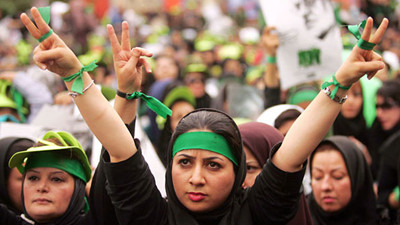伊朗革命
Waiting for God
等待真主
Debunking the myths that sustained Ayatollah Khomeini's republic
揭示領袖霍梅尼共和國之謎
Revolutionary Iran: A History of the Islamic Republic. By Michael Axworthy.
《伊朗革命:伊朗共和國的歷史》,作者:Michael Axworthy
“SLEEP easily, Cyrus, for we are awake,” assured Iran's last shah, Muhammad-Reza Pahlavi, speaking at the tomb of his imperial ancestor in 1971. This staged event helped forge the myth that the Pahlavis were an adored monarchy stretching back millennia to the Achaemenid empire, a claim to which the shah clung dearly. Yet in less than a decade his embittered people had delivered his throne into the hands of an obscure Shia cleric, Ayatollah Ruhollah Khomeini. James Buchan's elegant “Days of God”, which came out last November, focused on how all this came to pass. Now Michael Axworthy, a former diplomat and director of the Centre for Persian and Iranian Studies at Exeter University, goes over much of the same ground and explains how the Islamic republic has survived.
“Cyrus,有我們在,你們安心睡吧!”,1971年伊朗最后一位國王Muhammad-Reza Pahlavi在其先王墓前信心十足。從千年前緊握王權的阿契美尼德王朝直到巴列維王朝,一直深受愛戴,簡直是一個謎。盡管近10年來飽受疾苦的人民把其王朝政權交與一位不甚知名的牧師Ruhollah Khomeini之手,去年11月出版的James Buchan的《真主之日》簡潔而又著重解釋了這一形成原因。前外交官兼埃克塞特大學伊朗研究中心負責人Michael Axworthy在書中探討了這一地區,同時解釋了伊朗政權幸存下來的原因。

The shah's gaudy fete at Persepolis, not far from Cyrus's tomb, held to celebrate the monarchy's 2,500th birthday, epitomised a half-century of montazh: a succession of flashy buildings and self-congratulatory statues which helped to conceal the dislocations of a society on fast-forward. Construction faltered for lack of cement; many of Iran's ports became clogged with shiploads of imports. The minister of the shah's court, driving through Tehran in his Chrysler Imperial in 1969, noticed dingy side streets with “not an ounce of asphalt”. Lashing out at the grandiose party at Persepolis, Ali Shariati, an Iranian leftist writer, denounced 5,000 years of deprivation and social injustice. Khomeini, then in exile in Iraq, thundered for the first time that Islam was fundamentally opposed to monarchy.
離伊朗王賽勒斯墳墓不遠處的波斯波利斯曾舉行了盛大的宴會慶祝伊朗王朝成立2500周年,通過畫面剪輯簡單回顧了一下伊朗半個世紀以來的歷史:一排排高樓大廈,一座座自我標榜的雕像,這些都掩蓋了這個快速發展國家背后的混亂。缺乏混凝土結構的建筑搖搖欲墜,船舶上的進口商品使得港口混亂不堪。1969年伊朗王朝法官乘坐克萊斯勒帝國旗艦名車前往德黑蘭(Tehran),就注意到街道兩邊混亂不堪,沒有一條柏油路。伊朗左翼作家Ali Shariati猛烈抨擊波斯波利斯的奢華盛會,指責5000年的政權廢止和社會的不公。當時被流放伊拉克的霍梅尼大聲疾呼伊朗人民是堅決反對皇權的。
A hodgepodge of Marxists and other leftists allied themselves at first to the religious fundamentalists in common cause against the shah, inspiring Iranian students, in particular, to rise up against his rule. Within a few years, though, the left had lost out to Shia Islamic political groups that were, Mr Axworthy writes, “more flexible, more charismatic, more in tune with Iranian realities and less hidebound”. Like Mr Buchan, Mr Axworthy has mined newly opened archives to good effect. He lays bare the failure of Western governments to keep abreast of fast-changing events. One British dispatch saw “no threat to basic stability” in late 1977; another asked whether Iranians were still “the epitome of idleness”. The Iranian hostage-takers were astounded to find that, of the four CIA officers in the American embassy in Tehran, none could speak Persian.
那些信奉傳統基督教的馬克思主義者和左派人士首次聯合起來,尤其還煽動學生共同抵抗伊朗王的統治。Axworthy寫到,在近幾年里,脫離什葉派團體的左翼人士“更加靈活,有感召力,與時俱進與伊朗現實相結合”。與Mr Buchan一樣,他也恰到好處地引用了最近公開的史料,還指出了西方政府在獲取重大事件方面的不足,例如1977年底英國報道認為“不會威脅到基本穩定”,另一西方媒體認為伊朗是不是在虛張聲勢。伊朗人質劫持者驚奇地發現美國駐德黑蘭大使館的4名CIA人員不會說波斯語。
Balancing scholarly precision with narrative flair, Mr Axworthy depicts an Islamic movement that exploited and distorted traditional Shia beliefs in order to seize and hold on to power. Cycles of protest and mourning, 40 days long and timed to coincide with Shia holy days—Mr Buchan's “days of God”—were like “a great revolutionary lung”, inhaling indignation, exhaling more demonstrations. Khomeini's theory of divine rule, velayat-e faqih, still unknown to most in 1979, represented a complete innovation in Shia religious thinking. The Shia Muslim tradition believes the Mahdi, its messiah, will return, but its adherents had not previously considered putting themselves in power.
為了平衡學術的準確性和敘述的技巧,Axworthy曲解了傳統的什葉派信仰來描述伊朗運動。在長達40天的什葉圣日期間,伊朗人民的不斷抗議和哀悼就像“一個巨大的革命之肺”,吸入怨恨,吐出更多的游行示威。代表什葉派精神全面革新的霍梅尼神權統治—法吉赫的監護在1979年還不為大多數人所知。什葉派穆斯林堅信他們的救世主會降臨,但是其擁蹙之前并沒有讓他們掌權。
Revolutionary jargon justified purges and trials (the regime executed 2,946 people in 1981 alone, according to Amnesty International). Those who survived bombs set off by the radical left and other secularists were glorified as shaheed-e zendeh, or living martyrs. Fundamentalist rhetoric also fed popular fervour for an eight-year war against Iraq, framing the struggle as a continuation of the ancient fight between the evil caliph Yazid and the martyred Hussein, who was killed at the battle of Karbala in 680. Military offensives were named after that sacred Shia site; the last big assault, Karbala-5, fought around Fish Lake, a huge artificial basin on Iraqi defence lines, was also the most wretchedly wasteful. Around 20,000 Iranians are believed to have died.
假借革命之意使得審查肅反合理化。那些幸免于左派引發的戰亂和非宗教信仰者被歌頌為shaheed-e zendeh,英雄。正統基督主義輿論也支持長達八年的兩伊戰爭,仿佛古代殘暴領袖Yazid和烈士Hussein戰斗的續曲。“卡爾巴拉5號”軍事行動以什葉圣城—卡爾巴拉命名,在伊拉克防線人工湖—魚湖附近展開戰斗,戰爭極其殘酷,據稱有20000伊朗人死亡。
Mr Axworthy does the best job so far of describing the Iran-Iraq war. He draws on first-hand accounts of pilots, lieutenants and militia, and challenges the accepted notion that the Iranian air force was inept. The attacks were carried out according to intricate plans drafted under the shah, whose highly trained pilots were released from prison. He also breaks from Mr Buchan's thesis that Khomeini was bent on exporting Islamic government to Iraq, arguing instead that he saw the conflict as a just war to fend off a real threat. Drawing on Persian eyewitness accounts, he conjures up the chaos: the scramble for masks in nerve-gas attacks; paper-thin lungs blistered by mustard gas; fish, rotting and floating belly-up in an Iraqi lake brimming with barbed wire, electrodes and mines, “adding a new stench to the battlefield”.
Axworthy對兩伊戰爭做了迄今為止最好的描述,他引用了飛行員,軍官和民兵組織的第一手描述,對伊朗空軍實力孱弱這一根深蒂固的觀念提出了質疑,那些從監獄里釋放出來在伊朗王精細的指揮下襲擊敵人的飛行員,都是訓練素質很高的。對Buchan的關于霍梅尼想把伊朗政府轉移至伊拉克的論據Axworthy也提出了異議,他認為此次戰爭只是為了避免真正的威脅。根據伊朗目擊者描述,他在書中寫到這場混亂:大家爭搶防毒面具,肺部受到芥子氣的感染而起水泡變薄,伊拉克湖里的腐魚漫過鐵絲電網,礦井,使得“戰場上臭氣熏天”。
Yet the repressive Islamic republic of today was not at all inevitable. Reformist Iranian presidents succeeded one another, from Mehdi Bazargan and Abolhassan Bani-Sadr in 1980 to Muhammad Khatami in 1997. Evidence shows that Khomeini genuinely wanted to work with progressive governments—not least because he needed their credibility to rule. Mr Axworthy paints a nuanced picture of the ayatollah, who let army generals lead the war and his assembly of experts end it, although the ceasefire was “more deadly to than poison”.
然而今天專制的伊朗共和國并不都是不可避免的,伊朗改革派領導人一個接一個,從1980年的Mehdi Bazargan ,Abolhassan Bani-Sadr到1997年的Muhammad Khatami,這些都表明霍梅尼想與改革政府合作,而不只是因為他需要他們的信任來治理國家。Axworthy 對伊斯蘭宗教領袖也做了細致描述,其讓軍隊將領和集結的專家結束了這場戰爭,盡管此次停火協議“對于他而言比毒藥更致命”。
Mr Axworthy's analytical approach helps him demystify a revolutionary regime that has needed to feed off myths. He revisits, and convincingly reinterprets, defining moments of the Islamic republic. One is Khomeini's infamous response to a journalist as he returned to Tehran in February 1979, to cheering crowds. He felt “nothing”, he said—not because of a cold indifference to the Iranian people, but because he believed himself to be only a vehicle for the mind of God on Earth. The strength of Mr Buchan's rendering of Iran's story lies in its detail and its delicious storytelling; Mr Axworthy's, in his scholarly rigour and first-class analysis. Anyone interested in this most complex of revolutions would do well to read both.
Axworthy的分析揭開了革命政黨需要依靠宗教的神秘面紗,他重新清楚而又令人信服地解釋了伊朗共和國的種種事件,例如1979年2月霍梅尼重返德黑蘭鼓舞人民的那次臭名昭著的答記者問,霍梅尼感覺這沒有什么,并不是他對伊朗人民冷漠,而是因為他堅信她就是上帝意志的使者。Buchan著重于故事的趣味性和細節,而Axworthy則側重于學術的嚴謹和精湛的分析技巧。如果對這段復雜的革命史感興趣,不妨都拿來讀一讀。












